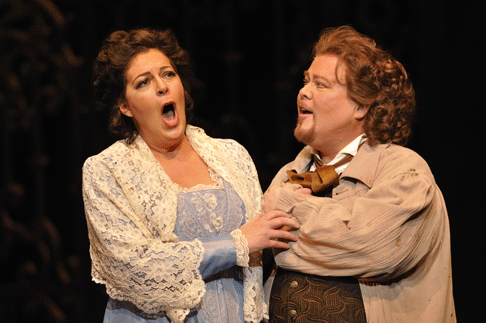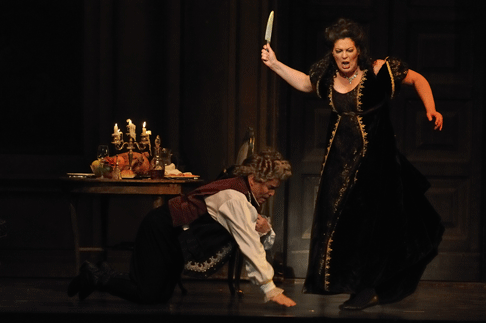23 Nov 2010
Tosca, Manitoba Opera
What some people won’t do for a standing ovation! Saturday night at the opera was a showcase of excesses.

What some people won’t do for a standing ovation! Saturday night at the opera was a showcase of excesses.
Puccini’s Tosca has everything: passionate love, consuming jealousy, undisguised lust, evil deceit, even murder and suicide. Manitoba Opera’s (MO) mostly Canadian cast rose to the occasion, leaving the audience emotionally spent but invigorated.
Conductor Tyrone Paterson led the Winnipeg Symphony Orchestra from the pit in Puccini’s marvellously dramatic score that foreshadows much of the onstage action. Vigorous playing and superb solo section work throughout provided exactly the added finesse required, making this a first-rate performance.
Veteran director Val Kuinka worked her magic with the help of an exemplary cast. Wendy Nielsen as Tosca and Richard Margison as artist Cavaradossi outdid themselves, portraying the tragic figures with realism and relish. Margison hasn’t lost a step as his extensive career continues. With a tenor voice that’s easy to listen to, he floated effortlessly to his upper range in “Recondita armonia.”
His wistful rendition of the celebrated aria “E lucevan le stelle” in the final act almost broke our hearts, his powerful voice aching with love for his adored Tosca. Totally convincing and touching, Margison crafted this into a real tearjerker and the clarinet solo introducing it was splendidly sensitive, enhancing our anticipation of this favourite.
Talk about art imitating life! Nielsen was outstanding as Tosca — a great actress, putting her entire being into the demanding role of the opera singer title character. With her lovely, refined soprano, she lent her full vibrato and flexible style to the twists and turns of the plot, moving fluidly from jealous lover to desperate murderess. In “Non la sospiri, la nostra casetta,” she showed a diaphanous lightness to her voice, barely alighting on each note before flitting to the next.
Rich phrasing and fervent zeal highlighted her “Visse d’arte, vissi d’amore,” as she sang, collapsed on the floor, disconsolate and despairing, beseeching God for deserting her despite her lifelong piety and humanity. Nielsen is the consummate opera star, with a reliable, mature voice that is completely satisfying. Powerful beyond belief, her dramatic cries of pain reached right into the audience’s hearts.
 Wendy Nielsen as Tosca and Richard Margison as Cavaradossi [Photo by R. Tinker courtesy of Manitoba Opera]
Wendy Nielsen as Tosca and Richard Margison as Cavaradossi [Photo by R. Tinker courtesy of Manitoba Opera]
Baritone Gaétan Laperrière returned to MO in the role of villainous chief of police Baron Scarpia. Dressed to the nines in black with gold braiding and trim, he looked every inch a self-indulgent scoundrel bent on getting his way. Yet Laperrière’s first entry was soft - barely discernible. His “Va Tosca!” was overly subtle, lacking power. And while his voice had agreeable resonance and flow, one wanted him to boom a little more, and strike fear into our hearts. Laperrière’s actions and words were suitably despicable, but his delivery belied his villainy. Frequent wooden movements were also questionable.
Peter Strummer’s droll Sacristan, on the other hand, was completely endearing. Announcing his arrival onstage with several healthy sneezes, he was a natural in this comic role. His bass-baritone made “E sempre lava!” a breath of fresh air before the drama to come. He has his gestures down to an art and gave us the only laughs of the evening.
Supporting roles by David Watson (Angelotti/Sciarrone), Keith Klassen (Spoletto) and Howard Rempel (jailer) were all solid and credible and Carson Milberg was a sweet-voice shepherd boy offstage. Acoustics can be tricky with offstage singing and it may be wise to station Milberg closer to the curtain to ensure the audience can fully appreciate this musical lad’s talents.
 Wendy Nielsen as Tosca and Gaétan Laperrière as Scarpia [Photo by R. Tinker courtesy of Manitoba Opera]
Wendy Nielsen as Tosca and Gaétan Laperrière as Scarpia [Photo by R. Tinker courtesy of Manitoba Opera]
The chorus is not especially busy in Tosca but certainly came through well when called upon and costuming was truly impressive.
The three sets were amazingly ornate and detailed, transporting us easily to 19th century Rome, and but for some shaky spotlighting, Bill Williams lighting was mood-setting splendour.